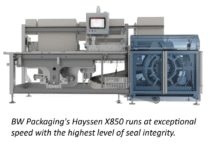Tinplate is a light gauge, cold reduced low carbon steel sheet or strip coated on both sides with commercially pure tin. It is a nine-layer sandwich consisting of oil film (barrier), chromium oxide, free tin layer, iron-tin alloy layer, and base steel in between.
Started by Tata Iron and Steel as a partnership with the Burmah Oil in 1920, the Tata Tinplate Company of India (TCIL) is one of the largest tinplate manufacturers in India. In 1973, TCIL started the electrolytic tinning process and adapted it to the technologies and background integration of the cold rolling mill in 1996. The company owns two plants containing cold rolling mills and tinning lines along with a state-of-the-art solution center that has a printing and lacquering line) at Jamshedpur.
Robust tinplate
Anirban Dasgupta, TCIL’s head of sales, extolls the robustness and inherent advantages of tinplate along with its attributes in packaging such as sustainability, safety, reliability, efficiency, and distinctiveness. While explaining each, he says, “Steel is the most recycled packaging material worldwide, and it can be recycled multiple times without losing its properties. These inherent properties of steel are carried forward to tinplate. Strong and durable, it has properties like impact and puncture resistance, 100% barrier protection against light, UV rays, water, and air.

Steel packaging is tamper-evident and reliable as it offers total product protection during transport and storage. It provides fast and efficient filling due to its strength and magnetic properties. In addition, it offers distinctiveness from the brand’s point of view, for example, different shapes and sizes, with compatibility for various applications.”
Dasgupta said that tinplate packaging and evolved from tinplated wrought-iron cans in 1810 and have now improved with the introduction of innovations such as peel-off-ends, self-heating cans, as tactile finishes. Now the future is moving towards active and intelligent packaging by adding track and trace, digital, and consumer engagement features to the packaging.
Indian packaging outgrows global trends
Packaging is moving towards sustainability, food safety, security, and cost-efficiency. In India, too, regulations influence packaging materials and design. He says, “The global packaging market has grown at a CAGR of 3% whereas the Indian market is growing at a CAGR of 11%. However, metal packaging’s share in India is only 6%, compared to 15% globally. In the coming seven to eight years, India’s growth rate is expected to be 38 to 40%. We believe that India has a much higher potential for the metal packaging need as well.”

The convenience and sustainability of metal packaging
According to Dasgupta, annual tinplate consumption in India is 0.55kg per capita. Edible-oils and paints end-use segments account for more than 80% of the demand for tinplate packaging. While imports cover 40% of the Indian market, the rest is serviced by TCIL (40%) and JSW (20%). He says, “India is one of the largest food producers in the world, but the quantum of food processing is considerably lower compared to other Asian countries. These countries know the advantages and the need to keep food materials safe for a longer time. India has a huge potential in this field.”
Today the brand has a very high value among consumers. He adds, “Trade-up mindset and growing brand affinity will drive consumption of packaged containers. Increasing nuclear families and working women in India fuel the demand for processed and packaged food in India. As a result, a huge pull is happening in the hotel, restaurant, cafe (HORECA) sector. This sector needs a good packaging medium for processing the right quality of food and getting it delivered to consumers.”
“The way forward is like in all other packaging. We need to innovate, collaborate and bring down the cost so that we meet the value-seeking mindset of the consumer,” he summarizes.
IndiFoodBev — authentic, impactful and influential
An English-language food and beverage processing and packaging industry B2B platform in print and web, IndiFoodBev is in its third year of publication. It is said that the Indian food and beverage industries represent approximately US$ 900 billion in revenues which implies more than 20% of the country’s GDP. Eliminating the wastage on the farmside can help to deliver more protein to a higher number of the population apart from generating sizable exports. The savings in soil, seeds, water, fertilizer, energy and ultimately food and nutrition could be the most immense contribution that country is poised to make to the moderation of climate change.
To improve your marketing and grow sales to the food and beverage processing and packaging industry, talk to us. Our research and consulting company IppStar [www.ippstar.org] can assess your potential and addressable markets in light of the competition. We can discuss marketing, communication, and sales strategies for market entry and growth.
Suppliers and service providers with a strategy and budget for targeted marketing can discuss using our hybrid print, web, video, and social media channels to create brand recognition linked to market relevance. Our technical writers are ready to meet you and your customers for content.
The second largest producer of fruit and vegetables in the world is continuously expanding processing capacities and delivery systems with appropriate innovative technologies. We cover product and consumer trends, nutrition, processing, research, equipment and packaging from farm to thali. Get our 2025 media kit and recalibrate your role in this dynamic market. Enhance your visibility and relevance to existing markets and turn potential customers into conversations. Ask for a sample copy of our bi-monthly in print or our weekly IndiFoodBev eZine each Wednesday.
For editorial info@ippgroup.in — for advertisement ads1@ippgroup.in and for subscriptions subscription@ippgroup.in
Naresh Khanna – 10 February 2025
Subscribe Now












